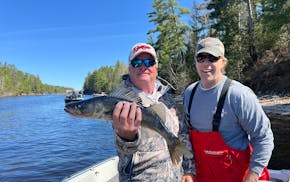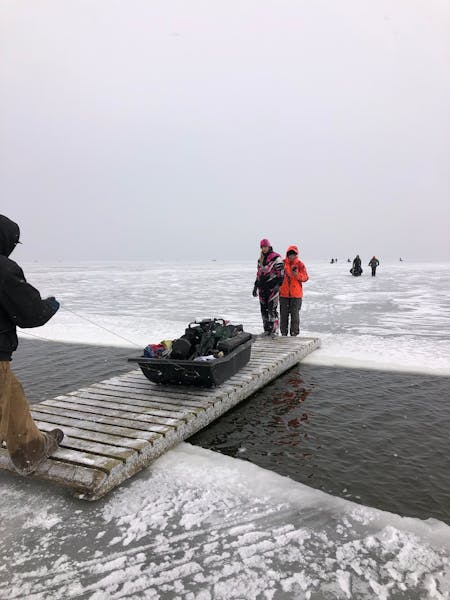On Wednesday about 200 anglers were stranded on Upper Red Lake when the ice they were standing on separated from ice nearer to shore. The anglers were rescued. But the incident prompts a question: Why are so many Minnesota walleye anglers so eager to venture onto thin ice in late November and early December? Are they more likely to catch more walleyes at that time than they would be a few weeks later, when lake ice is safer?
In the interview below, fisheries biologist and lake ecology scientist Paul Radomski of Brainerd, author of "Walleye. A Beautiful Fish of the Dark'' (University of Minnesota Press, $24.95), discusses walleye behavior during fall and early winter, and what it means for anglers.
Q: As summer turns to fall, how do walleyes react?
A: Many variables dictate a walleye's behavior, but water temperature is primary. In fall, with cooling water, walleyes become more active. This isn't only due to water temperature. Young-of-the-year minnows, perch, tullibees and other prey are larger and abundant at this time of year. This creates activity, and when fish are active, they're usually easier to catch. There are exceptions. But it's generally true that as water cools in fall fish become more active.
Q: When lake-water temperatures drop in fall, do walleyes behave the same way they do in spring when water temperatures also change, but from colder to warmer?
A: The two are quite different. In spring you have spawning thrown into the mix, which adds a level of complexity to walleye behavior. At that time walleyes are either about to spawn, spawning or wrapping up spawning. So they're generally in different locations than they are in fall, even though water temperatures at certain times might be the same. Also, in spring there is less forage available for walleyes than there is in fall. Which is why spring often is the best time to fish for walleyes — with the warmer water they're more active and increasing their feeding. Plus, there's a lack of forage.
Q: As water continues to cool in fall and lakes eventually "turn over,'' how are walleyes affected?
A: It's true that as lakes cool at some point they turn over, as you say, or become what is known as isothermal, meaning their temperature is consistent throughout various depths. This frees up a lot of space for fish to move around, though how much this affects fish movement can vary from lake to lake depending on water depth, underwater structure and so forth. Some lakes also will have algae blooms in fall and even in winter, under ice, which also can affect fish activity.
Q: Before a lake becomes isothermal, where will walleyes typically be? I ask this because fall walleye fishing oftentimes is hit or miss, with limits caught one day and nothing the next.
A: Again, walleyes will seek water of their preferred temperature — cool not warm — with abundant oxygen. So it's possible that during this time they are suspended at a certain water depth or possibly on top of a shallow-water hump or on the edge of a drop-off. It can depend on various factors. But water temperature, oxygen levels and forage availability will largely dictate their locations.
Q: In Minnesota, ice is usually forming on some lakes in the northern part of the state by Thanksgiving. This prompts a rush by some walleye anglers to fish "first ice,'' believing the action will be fast. As was the case last week on Upper Red Lake, this can mean anglers get onto ice too soon and endanger themselves. Why is walleye fishing believed to be so good at this time? And, in fact, is it a great time to fish for walleyes?
A: I'm not sure that fishing success at first ice is much different than it is just before ice forms on a lake. In both situations you generally have the same lake temperatures and probably an abundance of forage. The popularity of first ice might have more to do with people than walleyes. Ice fishing is easier, generally, than open water fishing. It's generally an enjoyable experience during a transition time for lakes and for fish, including walleyes, and it attracts people who probably don't fish in fall.
Q: But does ice forming on a lake trigger unusual walleye activity that produces a hot bite?
A: Ice affects light conditions in a lake, and as snow accumulates on ice, light intensity throughout the water column will be further affected. Because walleyes are accustomed to feeding in low light conditions, this in itself might open up a longer period of time that they're feeding.
Q: Ice anglers in winter usually fish for walleyes at the bottom of a lake, whereas at other times of the year they might fish, as you mentioned, over humps or along drop-offs or in shallow water.
A: Lakes in winter will stratify, with warmer water at the bottom. When it does, walleyes will seek out the warmer water.
Q: Why is lake water warmer at the bottom in winter?
A: It's complicated, but generally it has to do with the quirkiness of water molecules.
Q: You're saying the walleye bite probably isn't much different in late fall, before ice is formed, and just after ice is formed?
A: My belief is it isn't.
Q: Explain then why as winter progresses ice fishing success typically falls off, often by quite a bit.
A: As winter continues, the colder water temperatures further affect the metabolism of fish. Walleyes and other fish are still feeding, but more slowly. By contrast, say you were fishing for walleyes in the southern U.S. In that region, walleyes feed more in winter than in summer, when the water is so warm.
Q: Lake trout must have different metabolisms than walleyes, because in Minnesota, in and near the boundary waters, lake trout fishing can be very good even in the coldest winter months.
A: Lake trout do have different water temperature preferences than walleyes. They prefer much colder water.
Q: Winter ice fishing for walleyes has become more popular than it was even 15 years ago. Are walleyes vulnerable to overfishing in winter?
A: Angler walleye catch rates are much higher in spring than winter. But angler effort on some water bodies is higher in winter. Wheelhouses have helped change this. Now ice fishermen will go to a lake for a weekend and fish 24 hours a day. People are simply on the ice for much longer periods of time than they are in summer. Consequently, a greater percentage of the annual walleye harvest now occurs in winter on some water bodies. I don't necessarily see this as a bad thing. It's just a reallocation of when walleyes are removed from a lake.
Q: Ice fishing also has become very social.
A: True. I used to walk onto the ice, drill a hole and sit on a bucket to fish. You don't see many people doing that anymore.

Anderson: In early June, Minnesota fish are begging to be caught. Won't you help?

Anderson: Tails wagging, DNR officers' dogs find lost people and missing evidence
Anderson: Punish poachers more
Anderson: The Chainsaw Sisters Saloon is gone, but the Echo Trail is still a pathway to possibilities


